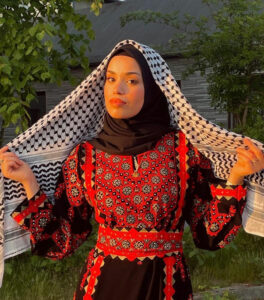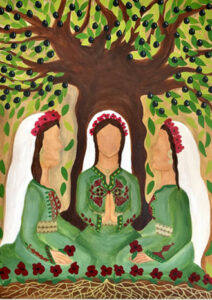World Day of Prayer
Friday 1st March 2024
You are invited to join in worship and fellowship at your local church. Programme prepared by WDP Committee of Palestine. Adapted for use in New Zealand by World Day of Prayer Aotearoa New Zealand.
Theme
“I beg you… bear with one another in love”.
An ecumenical group of Palestinian Christian women have prayed and reflected together over the past several years to respond to the invitation to write the 2024 program. Their theme is “I Beg You… Bear With One Another in Love,” based on Ephesians 4:1-7. This program calls us to bear with each other in love, despite all difficulties and oppression.
The Worship Service shares stories of three Palestinian Christian women, who witness to the power of bearing together in love. Their stories illuminate the experiences of Palestinian women from three different generations. The symbol of an olive tree is used throughout the worship service. This represents the three generations through the trunk, branches, and leaves of the olive tree.
The Palestinian Christian women who wrote this worship service have invited the world to pray for peace, justice and freedom of religion and freedom of movement. Their prayers specifically call us to pray with women, refugees, persons experiencing homelessness, and all who are sick, dying and grieving. They also call us to confess to our collective role in causing the climate crisis, and to commit to repairing what we have destroyed. Finally, they call us, the global church, to be united in treating all with justice and love.
Additional information be accessed and downloaded on our Resources page.
Country
Country Background Information
Who among you has not heard of this tiny spot in the Middle East, that for over 3000 years has been significant to three monotheistic religions: Judaism, Christianity, and Islam. However, the region is much older and has had many names, depending on the many tribes that have settled at different times in the land. The land has been nourished by an unfolding series of civilizations and structures because of its strategic position as a crossroad to three continents: Asia, Africa and Europe.
Geographical location
The Gaza Strip, or simply Gaza, is located on the eastern coast of the Mediterranean Sea, bordering Egypt and Israel. The total area of Gaza is 365 square kilometers (141 square miles), with over 2 million inhabitants. In 1967, when Israel occupied the Palestinian territories, Western powers called the region the West Bank, because it was on the west bank of the Jordan River. After the Oslo Accords of 1993-1995, the West Bank was divided into Areas A, B and C. One of the daily challenges that Palestinians face is the restriction of movement on their own land. In order to travel between any of the areas in the West Bank, Palestinians must go through checkpoints.
Featured Artwork / Artist

Artist: Halima Aziz
Halima Aziz (b.1999 in Hagen, Germany) is a passionate Palestinian visual artist and design student based in Germany. Her Mum is from Tulkarm and her Dad is from Gaza. Halima spent her childhood in Palestine. Halima had to experience the war in Gaza in 2008 and survived it. In 2009 she moved back to Germany.
Halima was interested in art from an early age and has always enjoyed painting. She started painting professionally in 2017 while participating in an art school project. Halima often likes to spontaneously let her creativity flow while she paints, trusting the process without planning in advance exactly how and what she wants to paint. But sometimes it takes planning, then she is doing sketches before making her paintings. She enjoys making colorful and eye-catching paintings, most of which express specific feelings or have a specific meaning. Halima is mostly inspired by nature, art museums, books or her native Palestine. Through her paintings she is proudly representing Palestinian heritage, identity, life, culture, history, and tradition. Halima feels closer to her homeland when she paints about it. Her artworks emphasize her feelings and emotions towards what she experienced in Palestine. With each brush stroke painted, she is expressing and highlighting the story of the Palestinian people and their struggle of resisting the occupation. Halima hopes her meaningful paintings inform the world of the Palestinian spirit. Never to be forgotten. Halima paints in acrylic and oil on canvas or sometimes with watercolors on fine art paper.
“I believe that through my artworks and other talented Palestinian artists’ artworks, people will understand more clearly how we Palestinians feel and what we have to go through. Everyone should care about it because it’s a human right issue. I hope and believe that one day Palestine will be free and that we will be able to peacefully return back to our homes and our families.” – Halima Aziz
Description of the artwork
This artwork is made in honour of the World Day of Prayer. Through her artwork, the artist represents three Palestinian women praying together in nature in a peaceful place. In her work, the artist has different motives and symbols that indicate the origin of these women and their cohesion. These are the following symbols featured in her artwork:
Olive trees/branches are a sign of everlasting and abundant life because they can live for thousands of years. Some of the olive trees in Palestine today were there during the time of Jesus.
The golden roots are underlining the fact that the Palestinians will always exist and as they exist, they will always resist for their rights and freedom. It is painted in gold because it is something precious, something no one can take away from the Palestinians because they are deeply rooted.
Poppy flowers are abundant and meaningful to Palestinians. They remind Palestinians of loved ones who have given their lives for their country.
Traditional Palestinian dresses like the tatreez (embroidery) thobe (dress) or the white scarf. It represents the Palestinian people and is full of art and history.
The keys are a symbol of the hope to return back to Palestine. Palestinians always carry their keys of their homes they were driven out of with them, no matter where they are around the world, and they pass it on to their children so they will never lose hope.


